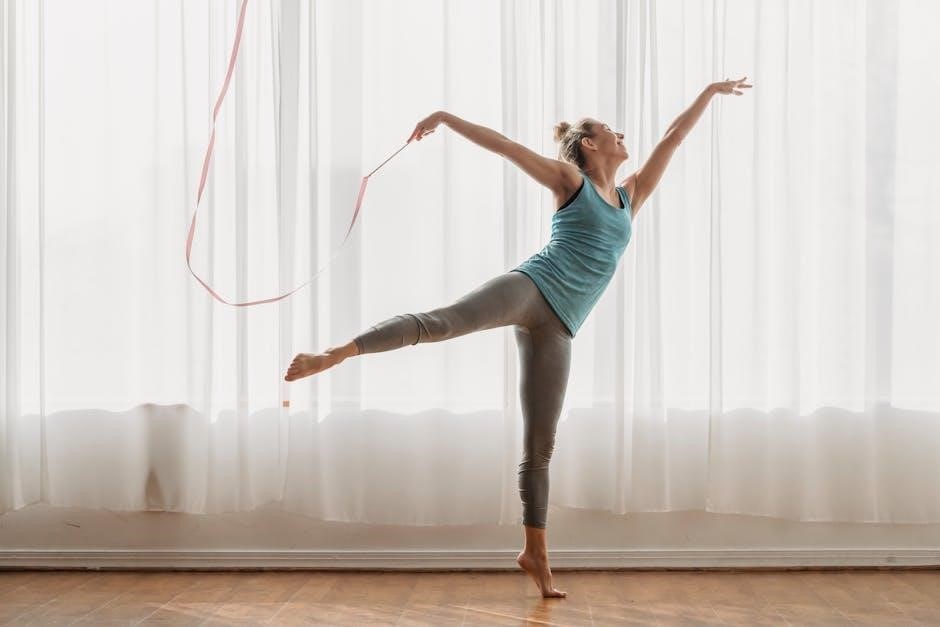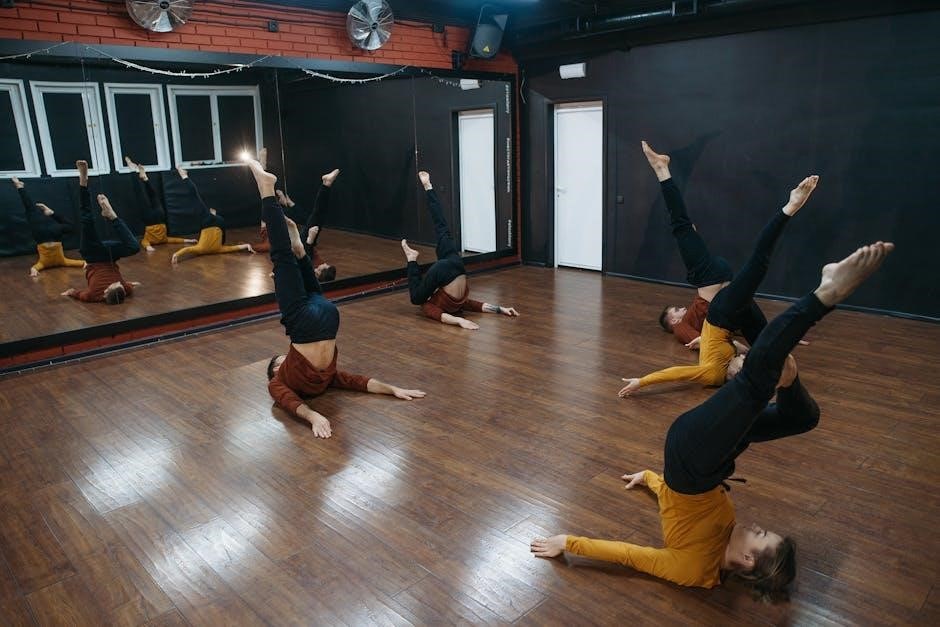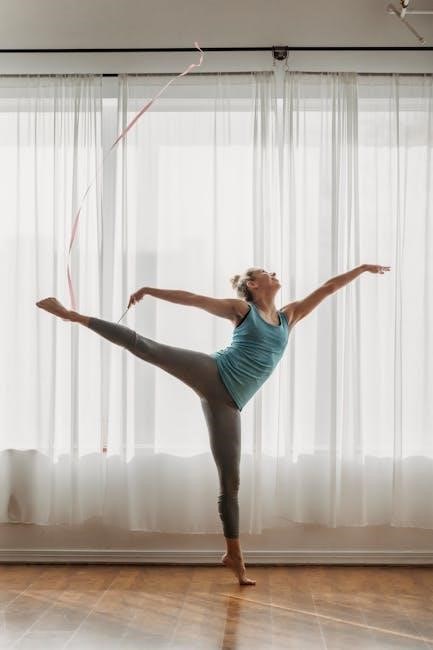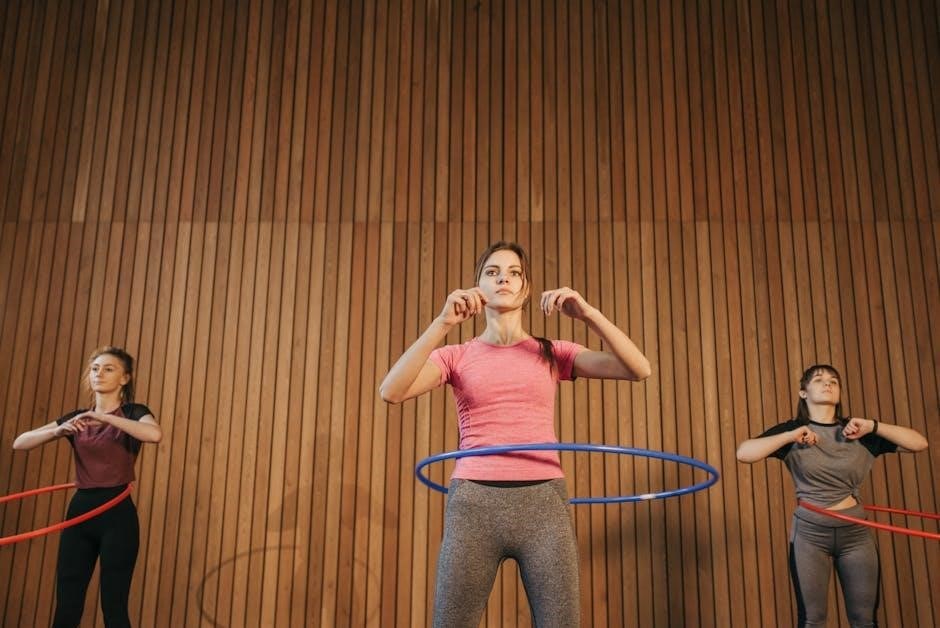Rhythm exercises are essential for developing timing and musical accuracy․ They involve clapping, counting, or playing musical patterns to improve rhythmic awareness and coordination․ Available as PDF downloads, these exercises provide structured practice for musicians of all levels, from simple note values to complex time signatures․
1․1 What Are Rhythm Exercises?
Rhythm exercises are structured activities designed to improve musical timing, coordination, and rhythmic accuracy․ They typically involve clapping, counting, or playing specific patterns that focus on note values, rests, and time signatures․ Available in PDF formats, these exercises provide a comprehensive way to practice rhythms, from simple whole and half notes to complex polyrhythms․ They are often used by musicians, educators, and students to build foundational skills and enhance musical performance․ Many resources offer downloadable PDFs with graduated difficulty, allowing learners to progress at their own pace․ These exercises are versatile, catering to vocalists, instrumentalists, and percussionists alike, ensuring well-rounded rhythmic development․ They are essential tools for both classroom settings and individual practice․
1․2 Importance of Rhythm in Music Education
Rhythm is a fundamental element of music, forming the backbone of timing and structure․ It enhances musical expression, coordination, and overall performance accuracy․ Rhythm exercises play a crucial role in music education by developing a strong sense of timing and improving coordination between mind and body․ They also foster discipline and concentration, essential for mastering any musical instrument or vocal technique․ PDF resources provide accessible and structured practice materials, ensuring consistent progress for students․ By incorporating rhythm exercises into music education, educators help students build a solid foundation, enabling them to interpret and perform musical pieces with confidence and precision․ This skill is invaluable for both individual practice and ensemble performances․
1․3 Benefits of Using PDF Resources for Rhythm Practice
PDF resources for rhythm practice offer numerous advantages, making them a popular choice among musicians and educators․ They provide structured exercises, from basic note values to complex time signatures, ensuring comprehensive skill development․ PDFs are easily accessible, downloadable, and printable, allowing for convenient practice anytime and anywhere․ Many resources are free or low-cost, making high-quality rhythm exercises affordable for all․ Additionally, PDFs can be used repeatedly without degradation, offering long-term value․ They also facilitate easy sharing among students and teachers, promoting collaborative learning․ With a wide variety of exercises available, PDF resources cater to different skill levels, from beginners to advanced musicians, ensuring personalized and effective rhythm practice․ This accessibility and flexibility make PDFs an indispensable tool for rhythm training․

Basic Rhythm Concepts
Understanding basic rhythm concepts is fundamental for musicians․ These include time signatures, note values, rests, and timing․ PDF resources provide exercises to master these foundational elements effectively․
2․1 Understanding Time Signatures
Time signatures are a fundamental concept in music, indicating how many beats are in each measure and which note gets the pulse․ A time signature consists of two numbers: the top number specifies the number of beats per measure, while the bottom number indicates the type of note that receives one beat․ For example, in 4/4 time, there are four beats per measure, and the quarter note gets one beat․ Common time signatures include 4/4, 3/4, and 2/4․ Understanding time signatures is crucial for accurate rhythm execution․ PDF resources often include exercises to practice recognizing and performing different time signatures, such as compound meter and cut time, helping musicians build a strong rhythmic foundation․
2․2 Note Values and Rests
Note values and rests are the building blocks of rhythm, determining the duration of sounds and silences․ Common note values include whole notes, half notes, quarter notes, eighth notes, and sixteenth notes․ Each note value represents a specific fraction of a beat, with whole notes lasting four beats and sixteenth notes lasting one-sixteenth of a beat․ Rests, which indicate silence, follow the same value system as notes․ Understanding note values and rests is vital for interpreting musical notation accurately․ PDF resources offer exercises that focus on recognizing and performing these elements, helping musicians develop rhythmic precision․ These exercises often progress from simple whole and half notes to more complex combinations of eighth notes and triplets, ensuring a comprehensive grasp of rhythmic fundamentals․
Timing and tempo are fundamental to rhythm, dictating the speed and feel of musical performance․ Tempo, measured in beats per minute (BPM), determines how quickly notes are played․ Common markings like allegro (fast) or adagio (slow) guide musicians․ Timing refers to the precise execution of note durations and rests within a given tempo․ PDF resources offer exercises that focus on playing accurately at varying tempos, helping musicians develop consistency and control․ These exercises often include metronome markings and gradual tempo increases, allowing for progressive skill-building․ Mastering timing and tempo enhances overall rhythmic accuracy and musical expression, making these exercises indispensable for all skill levels․

Rhythm Exercises for Beginners
Beginner rhythm exercises focus on foundational skills like whole, half, and quarter notes․ PDF resources provide simple, clear patterns for clapping or playing, ensuring a solid start․
3․1 Simple Whole and Half Note Studies
Simple whole and half note studies are the cornerstone of rhythm practice for beginners․ These exercises focus on recognizing and performing notes with longer durations, helping to establish a strong sense of timing and rhythmic accuracy․
Whole notes, which span four beats, and half notes, which span two beats, are introduced in isolation and then combined in various patterns․ PDF resources provide clear, visually structured exercises that make it easy for students to follow and practice these fundamental rhythms․
By mastering these basic note values, musicians build the foundation needed for more complex rhythmic challenges, ensuring a smooth transition to advanced studies in the future․
3․2 Practicing Eighth Notes and Triplets
Eighth notes and triplets introduce musicians to shorter note values and rhythmic subdivisions․ Eighth notes are represented by a single beam and occupy half a beat in 4/4 time, while triplets divide a single beat into three equal parts․ PDF resources offer exercises that isolate these rhythms, allowing for focused practice․ Clapping or playing along with these patterns while counting helps develop timing accuracy․ Progressing from basic to complex configurations, these exercises build fluency in reading and performing syncopated rhythms․ Incorporating MIDI files or SmartMusic can enhance practice by providing audible references․ Mastery of eighth notes and triplets is crucial for advancing to more intricate rhythmic challenges․
3․3 Basic Sight Reading Exercises
Basic sight reading exercises are designed to improve the ability to interpret and perform unfamiliar rhythms accurately․ PDF resources often include exercises that introduce new rhythmic elements gradually, such as whole, half, quarter, and eighth notes, in various time signatures․ These exercises encourage musicians to recognize patterns and maintain steady timing․ Clapping or playing along without prior preparation helps build confidence and quickens reaction time․ Many PDFs also provide space for writing counts below notes, reinforcing the connection between notation and timing․ Regular practice with these exercises fosters stronger rhythmic literacy, preparing musicians to tackle more complex scores with ease and precision․

Intermediate Rhythm Exercises
Intermediate rhythm exercises explore syncopation, rests, and mixed meters․ These PDF resources help musicians master complex patterns, enhancing timing and coordination through structured practice and application․
4․1 Sixteenth Notes and Complex Rhythms
Mastering sixteenth notes and complex rhythms is crucial for intermediate musicians․ PDF exercises focus on precise timing, incorporating syncopation and rests․ These resources help develop advanced rhythmic accuracy and control, essential for intricate musical pieces․ By practicing subdivisions and mixed meters, musicians enhance their coordination and musicality․ The exercises progress from basic sixteenth-note patterns to challenging combinations, ensuring a solid foundation for complex time signatures and polyrhythms․ Regular practice with these materials sharpens skills, preparing musicians for advanced repertoire and performances․ They are ideal for both individual study and classroom use, offering a comprehensive approach to rhythmic mastery․
4․2 Compound Meter and Cut Time
Compound meter and cut time offer unique challenges, requiring strong rhythmic understanding․ PDF resources provide exercises tailored to these concepts, focusing on subdivision and timing․ Compound meter emphasizes triplets and dotted rhythms, while cut time involves faster tempos and complex subdivisions․ These exercises help musicians navigate intricate time signatures with accuracy․ By practicing compound meter, students develop a strong sense of pulse and phrasing․ Cut time exercises enhance speed and precision, essential for advanced musical genres․ These PDFs include etudes and sight-reading materials, ensuring comprehensive practice․ Regular study of these exercises builds confidence and mastery, allowing musicians to tackle demanding repertoire with ease․ They are invaluable tools for refining rhythmic skills․
4․3 Advanced Sight Reading Techniques
Advanced sight-reading techniques are crucial for mastering complex rhythms․ PDF resources offer exercises designed to challenge experienced musicians, focusing on intricate time signatures and subdivisions․ These exercises often include unexpected rhythm changes, syncopation, and polyrhythms, helping to refine accuracy and musicality․ Clapping or playing while counting aloud enhances timing precision․ Many PDFs incorporate MIDI sheet music, allowing for interactive practice and better understanding of rhythmic nuances․ Regular sight-reading practice builds confidence and speed, enabling musicians to tackle demanding scores effortlessly․ Advanced techniques also involve identifying patterns and phrasing quickly, which are essential for professional performances․ These exercises are structured to progress from simpler to more complex rhythms, ensuring comprehensive skill development․

Resources for Rhythm Exercises
Explore a wide range of rhythm exercise resources, including free PDF downloads, MIDI sheet music, and interactive tools, all designed to enhance timing and accuracy for musicians․
5․1 Free PDF Downloads for Rhythm Practice
Free PDF downloads offer an accessible way to practice rhythm exercises․ Websites provide PDF files containing exercises for various skill levels, from basic note values to complex time signatures․ These resources often include worksheets, sight-reading exercises, and rhythmic patterns tailored for different instruments and vocalists․ Some PDFs are specifically designed for classroom use, while others cater to individual practice․ Many resources are available for immediate download, making it easy to start improving rhythmic accuracy․ Additionally, some sites offer free trials or subscriptions for premium content, ensuring a comprehensive learning experience for musicians of all levels․ Regular updates and new exercises keep the practice material fresh and engaging․
5․2 MIDI Sheet Music for Rhythm Exercises
MIDI sheet music offers a dynamic way to engage with rhythm exercises․ These files provide interactive features, allowing users to adjust tempo, isolate parts, and loop sections for focused practice․ MIDI files are compatible with various music software and apps, enabling real-time adjustments and enhancing the learning experience․ Many online platforms offer MIDI sheet music specifically designed for rhythm practice, covering a wide range of styles and complexity levels․ These resources are ideal for both individual and classroom use, as they can be easily shared and customized․ Additionally, MIDI files often complement PDF downloads, offering a comprehensive approach to mastering rhythm․ This format is particularly useful for developing timing accuracy and musical expression․
5․3 Recommended Workbooks and Guides
Recommended workbooks and guides are invaluable for structured rhythm practice․ Titles like Basics in Rhythm offer nine units of graduated exercises, starting with whole and half notes and progressing to complex rhythms․ These resources are designed to build a strong foundation in timing and note values․ Many workbooks include sight-reading exercises, making them ideal for both beginners and advanced musicians․ Websites like Percussion Exercises provide free and premium options, catering to diverse skill levels․ These guides often feature customizable worksheets, allowing educators to tailor exercises for specific needs․ By incorporating these materials into daily practice, musicians can enhance their rhythmic accuracy and overall musicality․ These workbooks are a cornerstone for effective rhythm training․

Practice Techniques
Clapping rhythms while counting, using tools like SmartMusic, and incorporating exercises into daily routines are effective techniques for improving timing and accuracy in rhythm practice․
6․1 Clapping Rhythms While Counting
Clapping rhythms while counting is a fundamental practice technique that enhances timing and coordination․ This method involves physically clapping the rhythmic patterns while verbally counting the beats․ It helps musicians develop a strong internal pulse and improves their ability to read and perform complex rhythms accurately․ By starting with simple exercises, such as whole and half notes, and progressing to more intricate patterns like triplets and sixteenth notes, learners can build a solid rhythmic foundation․ This technique is particularly effective when combined with PDF resources, which provide structured exercises that can be practiced regularly․ Clapping while counting also engages both auditory and kinesthetic learning, making it an ideal method for musicians of all levels․
6․2 Using SmartMusic for Rhythm Practice
SmartMusic is a powerful tool that offers interactive rhythm exercises, providing immediate feedback and enhancing practice efficiency․ It allows musicians to play along with accompaniment, record their performance, and receive detailed assessments․ With access to a vast library of rhythm exercises, users can tailor their practice sessions to specific needs, such as mastering complex time signatures or improving sight-reading skills․ The platform supports learning at all levels, from beginner to advanced, making it a versatile resource for both individual and classroom use․ By integrating technology with traditional practice methods, SmartMusic helps musicians achieve greater rhythmic accuracy and musicality, complementing the structured exercises found in PDF resources․ This blend of technology and tradition ensures comprehensive skill development․
6․3 Incorporating Rhythm Exercises into Daily Routine
Incorporating rhythm exercises into your daily routine is crucial for consistent progress․ Start with short, focused practice sessions, even 5-10 minutes, to build rhythmic accuracy․ Begin by clapping or tapping rhythms while counting aloud, ensuring a strong connection between physical movement and musical timing․ Use tools like SmartMusic or PDF worksheets to guide your practice, focusing on specific techniques such as sight-reading or complex time signatures․ Set achievable goals for each session, such as mastering a particular exercise or improving timing in a challenging piece․ Over time, this consistent practice will enhance your overall musicianship and make rhythm a second nature․ Regularity is key to long-term improvement․

Educational Applications
Rhythm exercises are widely used in educational settings to enhance musical understanding․ They are incorporated into classroom activities, assigned as homework, and integrated with musical pieces to build foundational skills․
7․1 Using Rhythm Exercises in Classroom Settings
Rhythm exercises are invaluable in classroom settings for fostering musical literacy․ Educators can distribute PDF worksheets to students, providing structured practice in timing and note values․ These exercises often include clapping activities and counting aloud, making learning engaging․ Teachers can incorporate rhythm studies into daily routines, ensuring consistent skill development․ Many resources offer graduated difficulty, starting with whole and half notes and progressing to complex rhythms․ Free and premium PDFs are available, catering to diverse classroom needs․ By integrating rhythm exercises, educators build a strong foundation for students, enhancing their ability to interpret and perform musical pieces confidently․ This approach creates an interactive and effective learning environment․
7․2 Assigning Rhythm Worksheets as Homework
Assigning rhythm worksheets as homework reinforces classroom learning and encourages independent practice․ Free and premium PDF resources offer exercises tailored to various skill levels, from basic note values to advanced time signatures․ Educators can select worksheets that align with lesson topics, ensuring students apply concepts learned in class․ Homework assignments might include clapping rhythms, writing counts below notes, or sight-reading exercises․ Parents and students can access these materials easily, and teachers can track progress through completed worksheets․ This method helps develop rhythmic accuracy and prepares students for more complex musical pieces․ Regular homework practice fosters discipline and strengthens foundational skills, essential for musical proficiency․leveraging PDFs makes distribution and grading efficient for educators․
7․3 Integrating Rhythm Practice with Musical Pieces
Integrating rhythm exercises with musical pieces enhances learning by applying theoretical concepts to practical performance․ PDF resources provide exercises aligned with specific compositions, allowing students to practice rhythms within the context of actual music․ This approach helps musicians connect abstract rhythmic patterns to real-world application, improving both technical skill and musicality․ Educators can assign worksheets that mirror the rhythmic challenges of upcoming pieces, ensuring students are well-prepared․ Additionally, incorporating rhythm practice into rehearsals strengthens ensemble cohesion and timing․ By linking exercises to repertoire, students develop a deeper understanding of rhythm’s role in music, fostering a more engaging and effective learning experience․ This integration bridges the gap between theory and practice, enriching overall musical development․

Rhythm Exercises for Specific Instruments
Instrument-specific rhythm exercises are tailored to address unique challenges for vocals, percussion, and other instruments․ PDF resources offer targeted practice sheets designed to enhance accuracy and technique for each instrument․
8․1 Percussion Exercises for Rhythmic Accuracy
Percussion exercises focus on developing timing and coordination through rhythmic accuracy․ PDF resources provide various drills, including complex time signatures and polyrhythms․ These exercises often involve clapping or playing along with rhythmic patterns to enhance precision․ Many percussion-specific PDFs include gradual difficulty levels, starting with basic note values and progressing to advanced subdivisions․ Additionally, they may incorporate musical dictation and sight-reading to improve overall rhythmic literacy․ By practicing these exercises regularly, percussionists can build a strong foundation in rhythm, essential for both solo and ensemble performances․ These PDFs are a valuable tool for musicians aiming to master rhythmic accuracy in their percussion playing․
8․2 Rhythm Practice for Vocalists
Vocalists benefit from rhythm exercises tailored to improve timing and phrasing․ PDF resources offer exercises that focus on counting, sight-reading, and syncing with accompaniments․ These exercises often include rhythmic patterns set to vocal melodies, helping singers develop a strong internal pulse․ Many PDFs provide gradual difficulty, starting with simple note values and progressing to complex rhythms․ Additionally, they may incorporate diction and breathing techniques to enhance overall performance․ By practicing these exercises, vocalists can improve their ability to interpret musical notation accurately and deliver performances with precision and confidence․ These PDFs are a valuable resource for vocalists aiming to refine their rhythmic skills and musical expression․
8․3 Instrument-Specific Rhythm Worksheets
Instrument-specific rhythm worksheets are designed to address the unique challenges of each musical instrument․ For example, percussionists benefit from exercises focusing on rhythmic accuracy and complex time signatures, while string players may practice bowing techniques in sync with rhythmic patterns․ Woodwind and brass players often work on articulation and phrasing in rhythm exercises․ These PDF resources are tailored to the technical demands of each instrument, ensuring targeted practice․ They often include etudes, scales, and arpeggios presented in rhythmic variations․ By focusing on instrument-specific needs, these worksheets help musicians build technical proficiency and musicality․ Many are available as free downloads, offering a convenient way to enhance rhythm skills․

Advanced Rhythm Topics
Advanced rhythm topics explore complex techniques like polyrhythms, rhythmic subdivision, and intricate time signatures․ These exercises challenge musicians to master sophisticated timing and coordination, enhancing their musical precision and expression․
9․1 Exploring Poly Rhythms
Polyrhythms involve playing multiple rhythms simultaneously, creating intricate musical textures․ For example, a 3:2 polyrhythm combines triplets with duplets․ PDF resources offer exercises to practice these complex patterns, improving timing and coordination․ Clapping or playing along with MIDI files enhances accuracy․ Advanced musicians can explore polyrhythms in various time signatures, challenging their rhythmic precision․ These exercises are essential for mastering intricate musical pieces and expanding rhythmic vocabulary․ Regular practice with polyrhythms strengthens musicality and versatility․
9․2 Practicing Rhythmic Subdivision
Rhythmic subdivision involves breaking down beats into smaller units, enhancing precision and musicality․ For example, dividing a quarter note into eighth or sixteenth notes improves timing accuracy․ PDF resources offer exercises that focus on subdivisions, such as clapping or playing along with MIDI files․ Advanced techniques include practicing subdivisions within complex time signatures or polyrhythms․ Regular practice strengthens the ability to internalize rhythms, making performance more confident and expressive․ Subdivision exercises are particularly useful for musicians aiming to master intricate musical pieces․ By incorporating these drills into daily routines, musicians can achieve greater control over rhythm and timing, elevating their overall musical proficiency․
9․3 Mastering Complex Time Signatures
Complex time signatures, such as 7/8 or 11/4, challenge musicians to think beyond common meters․ PDF resources provide exercises that focus on these unconventional time signatures, helping musicians develop a strong rhythmic foundation․ Practicing with MIDI files or sheet music allows for precise timing and repetition․ Exercises often include clapping or playing along with subdivided beats, ensuring accuracy․ Advanced techniques involve integrating complex time signatures into musical phrases, enhancing overall rhythmic awareness․ Regular practice with these exercises builds confidence and mastery, enabling musicians to tackle intricate compositions with ease․ These resources are invaluable for those seeking to deepen their understanding of rhythm and timing in diverse musical settings․

Additional Resources and Tools
Discover online platforms, mobile apps, and community forums offering rhythm exercises in PDF and MIDI formats․ These tools enhance practice and provide interactive learning experiences for musicians․
10․1 Online Platforms for Rhythm Practice
Various online platforms offer comprehensive rhythm practice tools, including interactive exercises and downloadable PDF sheets․ Websites like SmartMusic provide engaging workouts with rhythm-focused lessons, allowing users to clap and count along while receiving real-time feedback; Additionally, platforms such as MuseScore and Flat allow users to access and print rhythm exercises in PDF or MIDI formats, catering to both individual practice and classroom settings․ These resources often include graduated difficulty levels, ensuring that musicians from beginners to advanced players can benefit․ Many platforms also feature community-driven content, where users can share and discover new rhythm exercises, fostering a collaborative learning environment․
10․2 Mobile Apps for Rhythmic Training
Mobile apps have revolutionized rhythmic training by offering portable and interactive tools for musicians․ Apps like SmartMusic and Time Trainer provide engaging rhythm exercises, allowing users to clap or tap along with customizable tempos․ These apps often include features such as progress tracking, real-time feedback, and access to downloadable PDF sheets for offline practice․ Additionally, apps like Rhythm Cat and Music Tutor focus on sight-reading and timing exercises, making them ideal for both beginners and advanced players․ Many apps also integrate MIDI technology, enabling users to practice with high-quality backing tracks․ With these tools, musicians can enhance their rhythmic accuracy and musicality anywhere, anytime, making rhythmic training more accessible and enjoyable than ever․
10․3 Community Forums for Rhythm Discussion
Community forums provide a vibrant space for musicians to discuss rhythm exercises and share resources․ Platforms like Facebook groups, Reddit forums, and specialized music communities offer valuable insights and feedback․ Many forums host discussions on rhythm techniques, recommended PDF downloads, and MIDI sheet music․ Musicians often exchange tips on improving timing, sight-reading, and practicing complex rhythms․ These forums also serve as hubs for sharing free and premium resources, such as rhythm worksheets and exercise guides․ Engaging with these communities fosters collaboration and learning, helping musicians refine their rhythmic skills and stay updated on the latest training tools and methods․ Active participation can enhance one’s musical journey significantly․
